I created a document to describe how I built my "bollaplate": pdf
It is a bit rough, probably in an approximative English but it could contain some interesting tips.
It is in version 1.0 and can be improved...
Lookin' really sharp Vincent!
It makes sense to mount everything in the bottom, so as you noted there aren't cables getting stressed when you open the box. I made a couple of paper templates for another kit buyer and will post those soon for others to use. There are build options in the coil/AFE boxes OpenSCAD files to make them stand on their tall sides, I should probably include those in the kits too in order to give folks more mounting options. And I've been holding off on printing an I/O plate because I'm uncertain as to what exactly people will want to put on it, and the form factor, but it looks like you handled that very elegantly.
Thank you very much for sharing your build!
[EDIT] Vincent, I snagged your build PDF and put it on the D-Lev site, I hope you don't mind! If you want me to take it down, or if you'd rather I just used your Box link, please let me know.
And here are the paper hole cutting & drilling templates for anyone that is interested: https://d-lev.com/support/d-lev_templates.zip. There are two extra holes in each that shouldn't be drilled, they are for vertical alignment purposes.
Of course, you can put it on the D-Lev website.
However, be prepared for me to send you a new version from time to time if I improve it (or if some spelling mistakes are so itchy that they need to be corrected).
Paper templates will be a great help. Maybe just add a scale to the plan (e.g. 4 inches and 10 centimeter lines). So as one can check it is printed at the right size with a ruler.
"Of course, you can put it on the D-Lev website." - Mr_Dham
Thank you!
"However, be prepared for me to send you a new version from time to time if I improve it (or if some spelling mistakes are so itchy that they need to be corrected)."
Oh, definitely!
"Paper templates will be a great help. Maybe just add a scale to the plan (e.g. 4 inches and 10 centimeter lines). So as one can check it is printed at the right size with a ruler."
Great idea, thanks! It took me four tries and all morning: web search for ruler image (couldn't find any I could use), draw rulers in drawio (bad scaling), draw rulers in LibreCAD (bad scaling), and finally draw rulers in LibreOffice Draw (good scaling): https://d-lev.com/support/d-lev_templates_2022-03-03.zip
Emblematic
Been 3D printing all day, every day, for several weeks now. The main control panels take 8 hours to do and I'm getting a rather high reject rate. Finally got the adhesion issues under control, but get some minor discoloration here and there that is really random and hard to pin down why.
Anyway, it's getting near the time to print out the logo plates, and I've been experimenting with slicer options in the hope of reducing all the filling, sanding, and painting necessary to get them in shape.
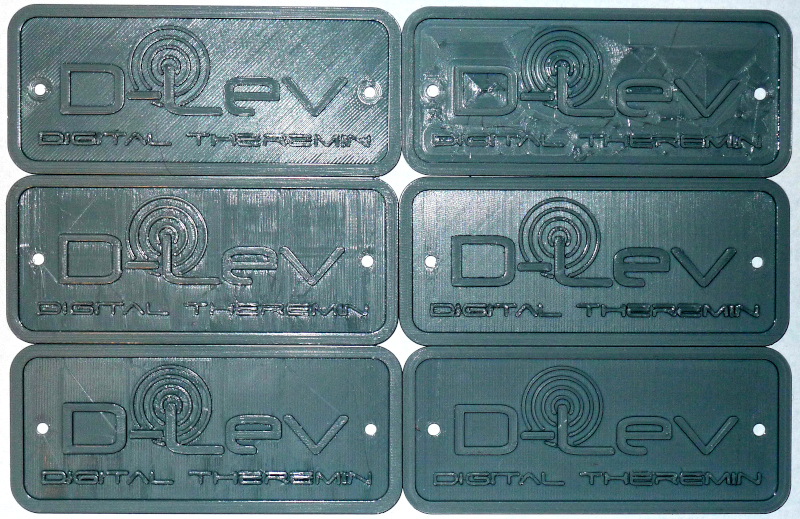
I bounced a light off of them and turned the contrast way up here so you can see the detail. At upper left I ironed the top most layer in the Prusa slicer, which is a big improvement as it fills in gaps the black paint can seep into, but the background will need multiple coats of primer and black to fill in the ripples. So I turned ironing on for all surfaces, but there are rapid movements that scratch it up. Tried ironing in the Cura slicer, and I like the concentric effect on the text, but it's a nightmare of blobs and scratches on the background (top right).
A lot of the problem is you can't specify a flat background in either slicer, they insist on stopping at the letters that get printed on top, so I sliced just the bottom, then the whole thing, and pieced the G codes together in a text editor. Tried Prusa first (center right) but decided to go with Cura here, as there were more ironing options, and the background ironing produces a lot less hair. Had to find the option for relative extruder movement to do so. So the bottom right is the final deal, it should be a snap to paint and sand.
Funneling Down
Getting around to all the soldering.
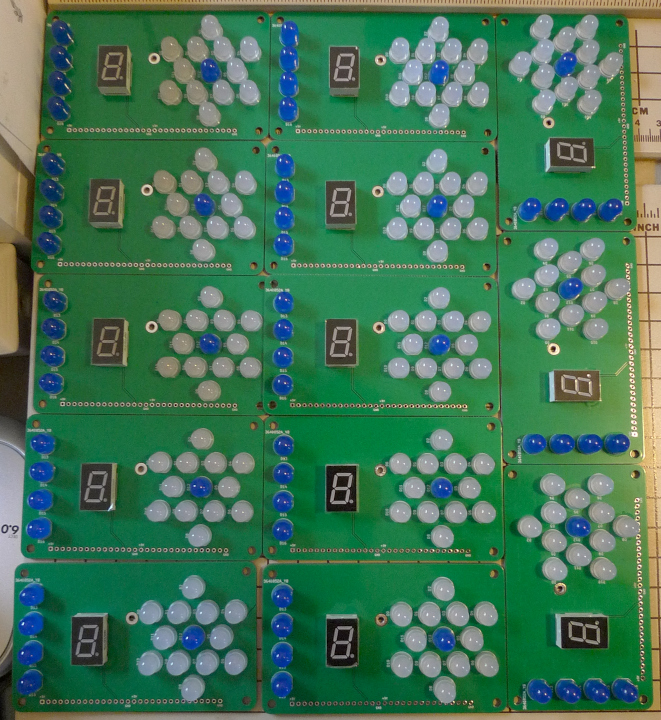
Built up 14 tuner PWBs & their driver PWBs and mounted them in the printed panels. Also did 28 AFE PWBs. So still need to do 14 main PWBs and 28 encoder PWBs.
Have 9 printed control panels, so 5 more to go. Getting a high discoloration reject rate of maybe 1/3, so I'm taking extra precautions like really giving the print nozzle a good toweling off before printing, and cleaning the powder coated mat off between prints. I'm using fuel grade alcohol on the mat to clean it, and to that end I printed a tiny funnel to fill the bottle:
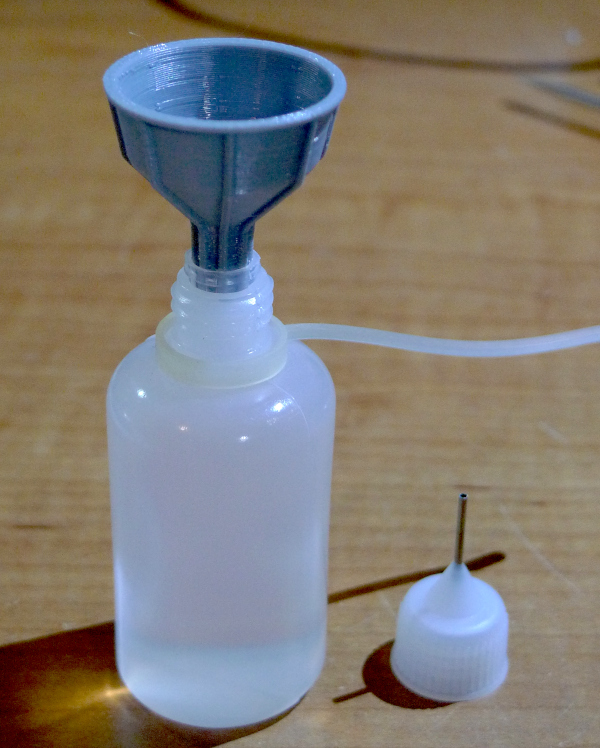
I love my little funnel!
Rob Schwimmer's first date with Patsy:
https://www.facebook.com/614507548/videos/688813435880725/
That preset is just amazingly expressive, and can be used over a really wide range without sounding weird.
Messing With Success
There are some D-Lev features that exist largely to cater to those who have honed their craft on an analog Theremin. Things volume field reversal (V_FIELD : Sens), volume field non-linearity (V_FIELD : Drop), and to some degree pitch preview. I actually welcome many of these features because they tend make the D-Lev more generic, and therefore more useful in a wider range of applications / situations.
One analog feature I'm considering adding is a knob to optionally make the pitch near-field non-linearly tighter. It goes against every fiber of my being to mess with this hard-won linearity, but I do see the value here because I realize that playing techniques are also hard-won, and should be accommodated if it isn't too difficult. It would be another item to add to the "features" list, and might be an interesting experiment to see if anyone ends up actually using it.
I don't have enough real-time on thread 0 to "undo" the linearity, but there is probably enough time remaining to introduce a simple polynomial. The 4th order volume drop was pretty easy because maximum volume is really nailed down, whereas maximum pitch isn't, so it could interact with the other field controls if applied at the very end of processing. The problem here is the field processing is done with floats, which are time consuming, so it's a difficult thing to tap into in the middle.
Another unknown is the exact form that the non-linearity polynomial should take. What's the best function to use here? Should it attempt to model a simple Theremin (e.g.Thierrymin), or one with a series EQ inductor (e.g. EW)?
Traditional Features vs. "Blameless" Traditional Modes
There are two ways to introduce traditional non-linearity in a linearized digital Theremin:
1. Provide features that warp the linear fields in various ways, or
2. Go whole-hog and mathematically model a heterodyned response (e.g. bypass the linearization step).
#1 is nice because warping strength can be controlled, which can have uses even in a linearized instrument. But this calls for some analysis and subsequent knob fiddling & detailed instructions in order to produce an authentic non-linear response.
#2 is nice because it is essentially "blameless" so purists will likely be more content with it. It also unifies the mathematical gauntlet for the volume and pitch processing, something that I've found that tends to point in the right direction on this project. But switching modes is all-or-nothing, so you can't use the features in more creative ways, though one could separate the mode switching for the pitch and volume fields to have them independent of each other, so folks could mix / match them.
Back in the salad days of this project, I found that taking the log2 of the heterodyned response, then subtracting some fraction of the squared response, is one way to do decent linearization. It isn't as robust as the method I finally discovered and implemented in the D-Lev (raising the heterodyned response to the -1/4 power). And it's more fiddly as it requires two knobs to tune instead of one (though Ofs- could be used for the center adjustment). But it gives us insight into how to implement non-linear features of a simple analog Theremin (i.e. one with no series EQ coil): to warp a linearized response we just need to add some portion of the squared response back in.
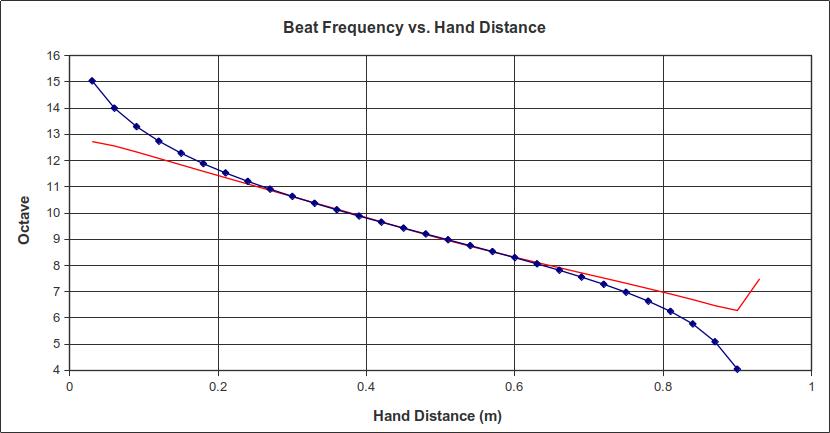
Above: Simple analog Theremin pitch response (blue), linearized via log2 and subtracted squared fraction (red).
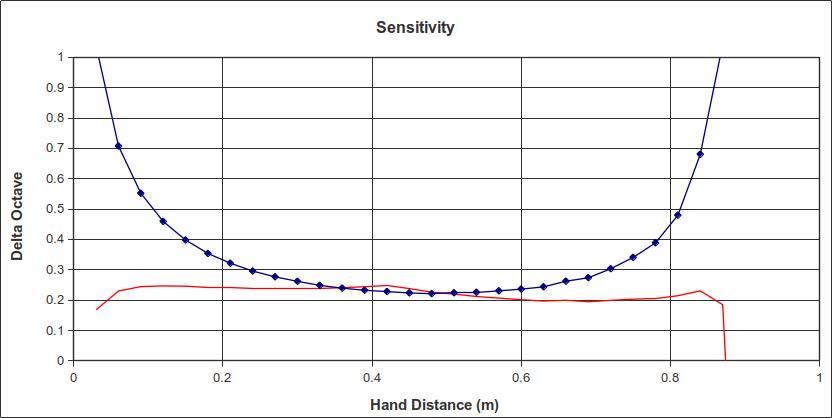
Above: Simple analog Theremin sensitivity response (blue), linearized via log2 and subtracted squared fraction (red).
If one goes the #1 route, one question is what to do with the non-linear far-field response. Do we leave it linear, or do we warp it along with the near-field? The "Drop" knob I implemented for the volume field only warps the quieter end of the response. And I have a candidate software load with a "Lift" knob which only warps the high pitch end of the response. But I could replace both of these with "Trad" knobs that switch to a purely analog type response when set to one. I haven't attempted to implement this mode yet, but will do so shortly.
"I realize that playing techniques are also hard-won" - Dewster
D-Lev's linearity is a kind of comfort zone. With a D-LEV properly tuned, the Theremin suddenly becomes easy to play, which is good.
As an average player, I am happy because I can focus on the music and not on how to deal with non-linearity.
Anyway, one could look at the problem in the opposit way: after a certain time, will I be able to use another theremin ?
But this can be resolved by playing an analog theremin from time to time in order to develop appropriate flexibility.
BTW, Is there two analogue theremin with same linearity and pitch response ?
That said, voulume "drop" is very helpfull in "higher-louder" volume mode in oder to reach silence before touching the plate.
Pitch "lift" would help to copy the effect of frequency that looks like going to infinite when reaching the antenna (I have it on my "no serial inductance" theremax). I used it as an effect but it never helped me for playing music precisely.
I wonder if one use far field non linearity (random oscillator synchronisation (=> no heterodyne), body movement interferences, other effect ...) ?
You must be logged in to post a reply. Please log in or register for a new account.